This thread is about motor oil basics…API classifications, SAE viscosity standards, API base stock groups, oil data sheets, and differences in synthetic vs mineral oil.
API Classifications & SAE Viscosity Standards:
This is what the American Petroleum Institute uses to meet the car manufacturer’s requirements for oil. You will see this on every oil container:

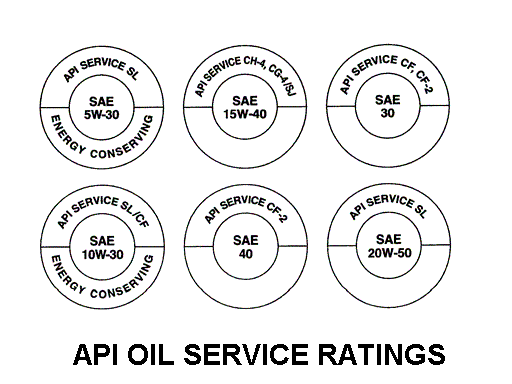
At the top you will see the API service category. The “S” designation means the oil is certified for gasoline engines…the 2nd letter is for the year(s) the service category is valid. For example, the MK III requires a SF (1988 and older engines) or SG (1993 and older engines) oil…both are obsolete. The current categories are SJ, SL, and SM…the good news is the categories are backwards compatible, and SJ, SL, or SM oil meets requirements for the 7M, 1J, or 2J motors.
At the bottom you may see the term “Energy Conserving”. Use of this oil will help with the fuel consumption of the engine. Typically, you will see it on the lighter weight multi-grade oils (i.e. 5W-30). To qualify as “Energy Conserving,” an engine oil must improve fuel economy in laboratory tests by at least 1.5% when compared with a reference oil. If the improvement is 2.7% or more, the oil can be labeled “EnergyConserving II.”
In the middle is the SAE viscosity. The 1st number is the oil’s cold flow viscosity at 40 deg C, the “W” means the oil meets SAE low temperature requirements of the 1st number, the last number is the oil viscosity at 100 deg C. An oil is rated for viscosity by heating it to a specified temperature, and then allowing it to flow out of a specifically sized hole. Its viscosity rating is determined by the length of time it takes to flow out of the hole. If it flows quickly, it gets a low rating. If it flows slowly, it gets a high rating. SAE viscosity rating system applies to both conventional and synthetic oils.
Here are the SAE requirements for grading oil:
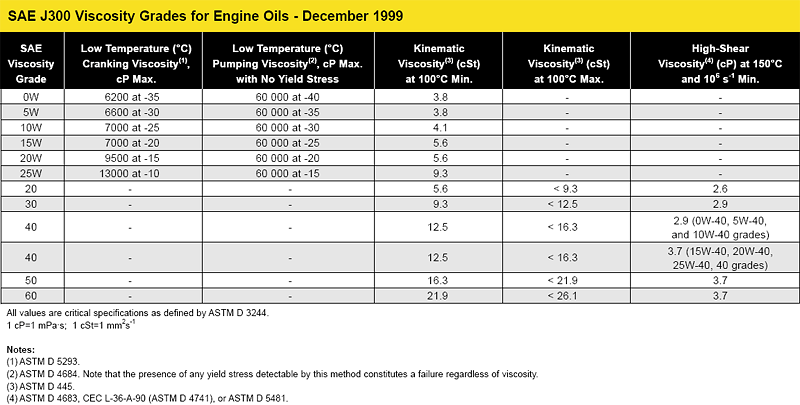
Here are the SAE/ISO viscosity ranges for oils:
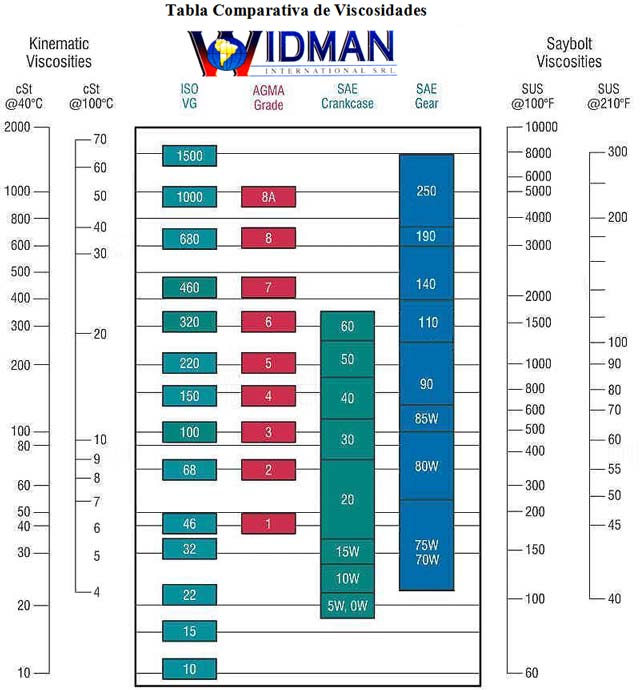
This is a handy detailed chart. Comparing it to an oil data sheet will tell you where the oil falls in a specific viscosity range…i.e. is the oil on the “thin side” of a 40W or the “thick side” of a 30W.
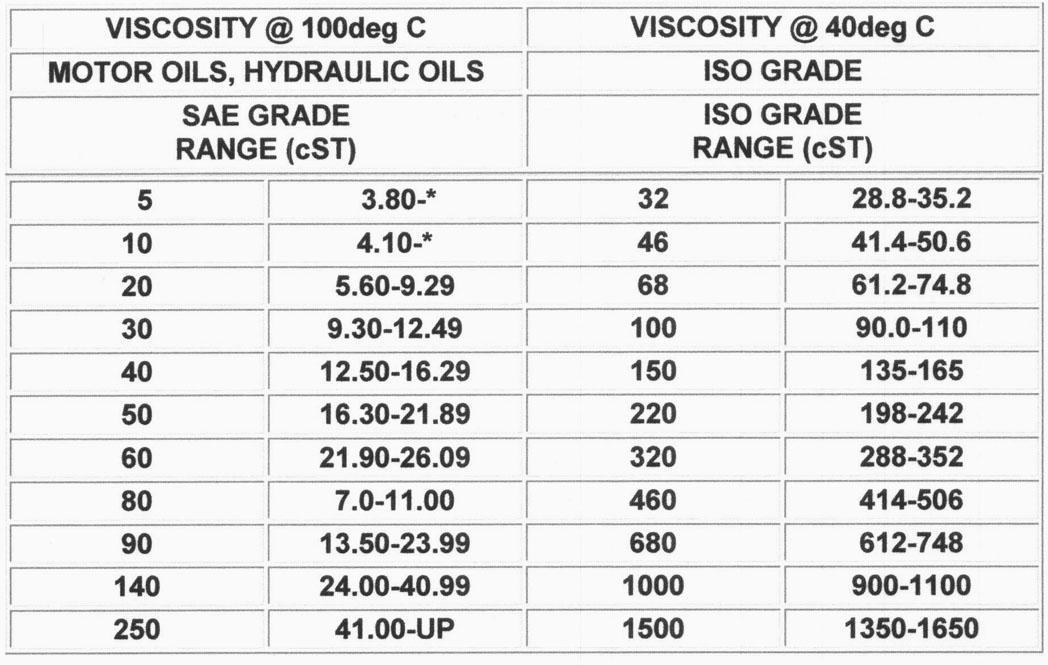
The International Lubricant Standardization and Approval Committee (ILSAC) also have standards for motor oil. Their latest standard, GF-4 was approved in 2004. A key test is the Sequence IIIG, involves running a GM 3.8L V6 at 125 horsepower, 3600 rpm, and 150°C oil temperature for 100 hours. These are much more severe conditions than any passenger car would see. The IIIG test is about 50% more difficult than the previous IIIF test, used in GF-3 and API SL oils.
Setting the standards for the European auto industry concerning oil is the ACEA. The ACEA A3/A5, and MB 229.5 tests used in Europe are even tougher and it is debatable whether this matters for normal drain intervals (5,000-7,000 miles).
The Japanese Automotive Standards Organization (JASO) has come up with their own set of standards for 4-stroke automotive engines. This standards (JASO-MB) is designed to address oil-requirement issues not addressed by the API service categories.
API Base Stock Groups:
Lubricant base stocks are categorized into five groups by the API:
Group I base stocks are composed of fractionally distilled petroleum which is further refined with solvent extraction processes to improve certain properties such as oxidation resistance and to remove wax. These oils are no longer very common and should never be used in an automotive engine.
Group II base stocks are composed of fractionally distilled petroleum that has been hydrocracked to further refine and purify it. These oils comprise many of the single grade motor oil you see on the shelf.
Group III base stocks have similar characteristics to Group II base stocks, except that Group III base stocks have higher viscosity indexes. Group III oils are produced by further hydrocracking of Group II base stocks, or of hydroisomerized slack wax. Manufacturers label Group III oils as standard motor oil or as synthetic in the US for marketing purposes. It depends on the level of refinement and additive pack. The ACEA in Europe does not allow a Group III oil to be labeled as “synthetic”.
Group IV base stocks are polyalphaolefins (PAO). These were the 1st synthetic oils produced.
Group V is a catch all group for any other synthetic base stocks. Examples of Group V base stocks include polyol esters (POE), polyalkylene glycols (PAG oils), and perfluoropolyalkylethers (PFPAEs). In addition, base stocks using Fischer-Tropsch-synthesis (gas-to-liquid) fall in this group.
POE oils are the most common Group V oils (Red Line for example), in fact, POE oils are used for lubrication in jet turbines and are some of the best oils available. All the Group V oils represent the latest in petroleum technology. But, just because oil is classified as Group V doesn’t mean that it’s better….Group V oils are simply synthetics that are not PAO based.
Oil Data Sheets:
Here is a typical data sheet…this one covers Red Line oils:
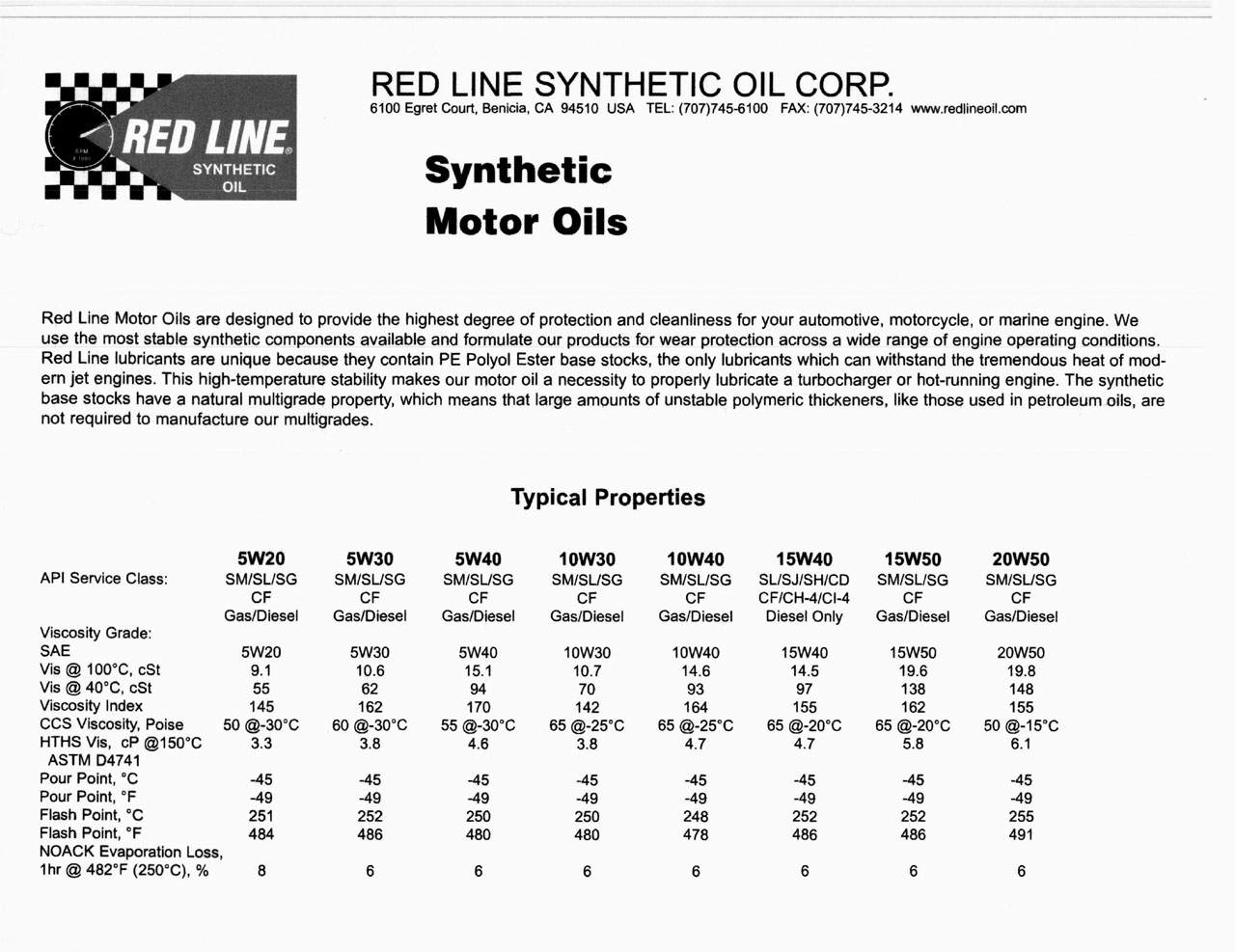
Viscosity Grade – Given as two values typically at 40 deg C and 100 deg C (this sheet also shows deg F). Both viscosities are shown in centistrokes (cSt), but can also shown in Saybolt Universal Seconds (SUS) usually at 100 deg F. You can convert using the following formula:
SUS @ 100 deg F/5=cSt @ 40 deg C
To convert SUS to cSt:
cSt= 0.226xSUS-(195/SUS)
The value given at 40 deg c is the ability of the oil to flow when cold (if you want to call 100 deg F cold)…the lower this value is, the better. It represents viscosity on that 1st start in the morning. The value at 100 deg C is the viscosity of the oil at operating temp….resistance to flow at this viscosity and temperature is what gives you the oil pressure you look for at 3000 rpm on the 7M engine.
Viscosity Index - indicates the rate of change in oil viscosity within a given temperature range. Higher numbers indicate a low change; lower numbers indicate a relatively large change. The higher the viscosity index, the better. This is one major property of oil that keeps your bearings happy. These numbers can only be compared within a viscosity range. It is not an indication of how well the oil resists thermal breakdown.
The next sets of numbers on this sheet are just different methods of expressing viscosity. The HTHS viscosity does provide an indication of how the oil reacts when very hot (150 deg C)
Pour Point – This is the temperature where 5 degrees F above the point at which chilled oil shows no movement at the surface for 5 seconds when inclined. This measurement is especially important for oils used in the winter. A borderline pumping temperature is given by some manufacturers. This is the temperature at which the oil will pump and maintain adequate oil pressure. Pump temperature is not given by a lot of the manufacturers, but appears to be about 20 degrees F above the pour point. The lower the pour point, the better.
Flash Point - the temperature at which oil gives off vapors that can be ignited with a flame. Lower the flash point indicates a greater tendency for the oil to suffer vaporization loss at high temperatures and to burn off on hot cylinder walls/pistons. The flash point can be an indicator of the quality of the base stock used. The higher the flash point, the better…400 deg F is about the minimum to prevent possible high consumption.
NOACK Evaporation Loss – Also known as NOACK Volatility. The Noack test determines how much weight loss an oil experiences through volatization. The test reports results in the percentage, by weight, lost due to "boil-off" at the temperature specified. The more motor oils vaporize, the thicker and heavier they become, contributing to poor circulation, reduced fuel economy, increased oil consumption, wear, and emissions. A maximum of 15 percent evaporation loss is allowable to meet API SL and ILSAC GF-3 specifications.
Synthetic vs. Mineral Oil:
The million dollar question
Especially with companies selling Group III oils in the US as “synthetic”, but does it really matter? Any Group III being sold as synthetic is highly refined and has a robust additive pack. If you buy almost any SL or SM rated oil and change it every 5000 mile, your motor will run well and last likely longer than you own it. What really bugs me is the prices they charge for oil that is not a true synthetic…if I’m going to use a synthetic oil, I want to get what I’m paying for.
IMO, a PAO or ester based oil is best for a turbo car. Synthetics resist high temperatures (like in a turbo center section) much better before they begin to break down. They also resist “coking” better than a mineral oil, making the use of a turbo timer less important. If you are picky about your engine, especially a turbo motor, you want to use a true synthetic.
Synthetic oil has higher purity and excellent mechanical properties at extremes of high and low temperatures. The molecules in synthetic oil are a uniform size and are engineered to be large enough and "softer" to retain good viscosity at higher temperatures. At the same time the molecular structure is branched…this interferes with solidification and therefore allows flow at lower temperatures.
The viscosity of a synthetic oil still decreases as temperature increases, but have a much improved viscosity index over traditional petroleum base. Their engineered properties allow a wider temperature range at higher and lower temperatures and often include a lower pour point and higher flash point. You will often see that synthetic oils have a lower viscosity in grade when compared to mineral oil in the same SAE viscosity…they tend to be thinner.
Synthetic oil viscosity changes much less with temperature, reducing the need for viscosity index improvers that are used with petroleum based oils. Viscosity index improvers are the oil components most vulnerable to thermal and mechanical degradation as the oil ages through use. Because these synthetic oils have little or no viscosity improver content, they do not degrade as quickly as traditional motor oils.
Like conventional oil, synthetics still fill up with particulate matter, so the oil filter must still be changed periodically. The ability of any oil, including synthetics, to resist oxidation from combustion by-products decreases over time. Synthetic oil (PAO or ester based) can easily handle change intervals as long as 12,000 miles….I would change the filter every 4000 miles and do oil analysis to be on the safe side when using an extended change interval.
Here are the commonly found oils that are true synthetics sold in the US:
Red Line
Royal Purple
Amsoil
Castrol European Formula (aka German Castrol)…only comes in 0W-30, sold at AutoZone.
There are others...this is not an all inclusive list.
How about the others marketed as synthetic?
Mobil 1 was PAO based until recently…it’s been confirmed that at least two of their oils have been switched to Group III. Mobil 1 EP 5W-30 and 15W-50. Since these are Mobil’s top-of-the-line, I suspect their remaining oils have done the same.
Pennzoil Platinum switched from a gas-to-liquid synthetic base to Group III
All the Castrol SynTec oils are Group III, except the German Castrol mentoned above.
All Valvoline and Quaker State oils are Group III
Want to know more? JetJock did a nice write-up at Mk III Tech:
http://www.mkiiitech.com/forum/showthread.php?t=869
This is also required reading for those who want to be educated on motor oil facts…Dr Haas is a true authority on the subject:
Motor Oil 101
For the true oil geek
http://www.bobistheoilguy.com/
API Classifications & SAE Viscosity Standards:
This is what the American Petroleum Institute uses to meet the car manufacturer’s requirements for oil. You will see this on every oil container:


At the top you will see the API service category. The “S” designation means the oil is certified for gasoline engines…the 2nd letter is for the year(s) the service category is valid. For example, the MK III requires a SF (1988 and older engines) or SG (1993 and older engines) oil…both are obsolete. The current categories are SJ, SL, and SM…the good news is the categories are backwards compatible, and SJ, SL, or SM oil meets requirements for the 7M, 1J, or 2J motors.
At the bottom you may see the term “Energy Conserving”. Use of this oil will help with the fuel consumption of the engine. Typically, you will see it on the lighter weight multi-grade oils (i.e. 5W-30). To qualify as “Energy Conserving,” an engine oil must improve fuel economy in laboratory tests by at least 1.5% when compared with a reference oil. If the improvement is 2.7% or more, the oil can be labeled “EnergyConserving II.”
In the middle is the SAE viscosity. The 1st number is the oil’s cold flow viscosity at 40 deg C, the “W” means the oil meets SAE low temperature requirements of the 1st number, the last number is the oil viscosity at 100 deg C. An oil is rated for viscosity by heating it to a specified temperature, and then allowing it to flow out of a specifically sized hole. Its viscosity rating is determined by the length of time it takes to flow out of the hole. If it flows quickly, it gets a low rating. If it flows slowly, it gets a high rating. SAE viscosity rating system applies to both conventional and synthetic oils.
Here are the SAE requirements for grading oil:

Here are the SAE/ISO viscosity ranges for oils:

This is a handy detailed chart. Comparing it to an oil data sheet will tell you where the oil falls in a specific viscosity range…i.e. is the oil on the “thin side” of a 40W or the “thick side” of a 30W.
The International Lubricant Standardization and Approval Committee (ILSAC) also have standards for motor oil. Their latest standard, GF-4 was approved in 2004. A key test is the Sequence IIIG, involves running a GM 3.8L V6 at 125 horsepower, 3600 rpm, and 150°C oil temperature for 100 hours. These are much more severe conditions than any passenger car would see. The IIIG test is about 50% more difficult than the previous IIIF test, used in GF-3 and API SL oils.
Setting the standards for the European auto industry concerning oil is the ACEA. The ACEA A3/A5, and MB 229.5 tests used in Europe are even tougher and it is debatable whether this matters for normal drain intervals (5,000-7,000 miles).
The Japanese Automotive Standards Organization (JASO) has come up with their own set of standards for 4-stroke automotive engines. This standards (JASO-MB) is designed to address oil-requirement issues not addressed by the API service categories.
API Base Stock Groups:
Lubricant base stocks are categorized into five groups by the API:
Group I base stocks are composed of fractionally distilled petroleum which is further refined with solvent extraction processes to improve certain properties such as oxidation resistance and to remove wax. These oils are no longer very common and should never be used in an automotive engine.
Group II base stocks are composed of fractionally distilled petroleum that has been hydrocracked to further refine and purify it. These oils comprise many of the single grade motor oil you see on the shelf.
Group III base stocks have similar characteristics to Group II base stocks, except that Group III base stocks have higher viscosity indexes. Group III oils are produced by further hydrocracking of Group II base stocks, or of hydroisomerized slack wax. Manufacturers label Group III oils as standard motor oil or as synthetic in the US for marketing purposes. It depends on the level of refinement and additive pack. The ACEA in Europe does not allow a Group III oil to be labeled as “synthetic”.
Group IV base stocks are polyalphaolefins (PAO). These were the 1st synthetic oils produced.
Group V is a catch all group for any other synthetic base stocks. Examples of Group V base stocks include polyol esters (POE), polyalkylene glycols (PAG oils), and perfluoropolyalkylethers (PFPAEs). In addition, base stocks using Fischer-Tropsch-synthesis (gas-to-liquid) fall in this group.
POE oils are the most common Group V oils (Red Line for example), in fact, POE oils are used for lubrication in jet turbines and are some of the best oils available. All the Group V oils represent the latest in petroleum technology. But, just because oil is classified as Group V doesn’t mean that it’s better….Group V oils are simply synthetics that are not PAO based.
Oil Data Sheets:
Here is a typical data sheet…this one covers Red Line oils:
Viscosity Grade – Given as two values typically at 40 deg C and 100 deg C (this sheet also shows deg F). Both viscosities are shown in centistrokes (cSt), but can also shown in Saybolt Universal Seconds (SUS) usually at 100 deg F. You can convert using the following formula:
SUS @ 100 deg F/5=cSt @ 40 deg C
To convert SUS to cSt:
cSt= 0.226xSUS-(195/SUS)
The value given at 40 deg c is the ability of the oil to flow when cold (if you want to call 100 deg F cold)…the lower this value is, the better. It represents viscosity on that 1st start in the morning. The value at 100 deg C is the viscosity of the oil at operating temp….resistance to flow at this viscosity and temperature is what gives you the oil pressure you look for at 3000 rpm on the 7M engine.
Viscosity Index - indicates the rate of change in oil viscosity within a given temperature range. Higher numbers indicate a low change; lower numbers indicate a relatively large change. The higher the viscosity index, the better. This is one major property of oil that keeps your bearings happy. These numbers can only be compared within a viscosity range. It is not an indication of how well the oil resists thermal breakdown.
The next sets of numbers on this sheet are just different methods of expressing viscosity. The HTHS viscosity does provide an indication of how the oil reacts when very hot (150 deg C)
Pour Point – This is the temperature where 5 degrees F above the point at which chilled oil shows no movement at the surface for 5 seconds when inclined. This measurement is especially important for oils used in the winter. A borderline pumping temperature is given by some manufacturers. This is the temperature at which the oil will pump and maintain adequate oil pressure. Pump temperature is not given by a lot of the manufacturers, but appears to be about 20 degrees F above the pour point. The lower the pour point, the better.
Flash Point - the temperature at which oil gives off vapors that can be ignited with a flame. Lower the flash point indicates a greater tendency for the oil to suffer vaporization loss at high temperatures and to burn off on hot cylinder walls/pistons. The flash point can be an indicator of the quality of the base stock used. The higher the flash point, the better…400 deg F is about the minimum to prevent possible high consumption.
NOACK Evaporation Loss – Also known as NOACK Volatility. The Noack test determines how much weight loss an oil experiences through volatization. The test reports results in the percentage, by weight, lost due to "boil-off" at the temperature specified. The more motor oils vaporize, the thicker and heavier they become, contributing to poor circulation, reduced fuel economy, increased oil consumption, wear, and emissions. A maximum of 15 percent evaporation loss is allowable to meet API SL and ILSAC GF-3 specifications.
Synthetic vs. Mineral Oil:
The million dollar question
Especially with companies selling Group III oils in the US as “synthetic”, but does it really matter? Any Group III being sold as synthetic is highly refined and has a robust additive pack. If you buy almost any SL or SM rated oil and change it every 5000 mile, your motor will run well and last likely longer than you own it. What really bugs me is the prices they charge for oil that is not a true synthetic…if I’m going to use a synthetic oil, I want to get what I’m paying for.
IMO, a PAO or ester based oil is best for a turbo car. Synthetics resist high temperatures (like in a turbo center section) much better before they begin to break down. They also resist “coking” better than a mineral oil, making the use of a turbo timer less important. If you are picky about your engine, especially a turbo motor, you want to use a true synthetic.
Synthetic oil has higher purity and excellent mechanical properties at extremes of high and low temperatures. The molecules in synthetic oil are a uniform size and are engineered to be large enough and "softer" to retain good viscosity at higher temperatures. At the same time the molecular structure is branched…this interferes with solidification and therefore allows flow at lower temperatures.
The viscosity of a synthetic oil still decreases as temperature increases, but have a much improved viscosity index over traditional petroleum base. Their engineered properties allow a wider temperature range at higher and lower temperatures and often include a lower pour point and higher flash point. You will often see that synthetic oils have a lower viscosity in grade when compared to mineral oil in the same SAE viscosity…they tend to be thinner.
Synthetic oil viscosity changes much less with temperature, reducing the need for viscosity index improvers that are used with petroleum based oils. Viscosity index improvers are the oil components most vulnerable to thermal and mechanical degradation as the oil ages through use. Because these synthetic oils have little or no viscosity improver content, they do not degrade as quickly as traditional motor oils.
Like conventional oil, synthetics still fill up with particulate matter, so the oil filter must still be changed periodically. The ability of any oil, including synthetics, to resist oxidation from combustion by-products decreases over time. Synthetic oil (PAO or ester based) can easily handle change intervals as long as 12,000 miles….I would change the filter every 4000 miles and do oil analysis to be on the safe side when using an extended change interval.
Here are the commonly found oils that are true synthetics sold in the US:
Red Line
Royal Purple
Amsoil
Castrol European Formula (aka German Castrol)…only comes in 0W-30, sold at AutoZone.
There are others...this is not an all inclusive list.
How about the others marketed as synthetic?
Mobil 1 was PAO based until recently…it’s been confirmed that at least two of their oils have been switched to Group III. Mobil 1 EP 5W-30 and 15W-50. Since these are Mobil’s top-of-the-line, I suspect their remaining oils have done the same.
Pennzoil Platinum switched from a gas-to-liquid synthetic base to Group III
All the Castrol SynTec oils are Group III, except the German Castrol mentoned above.
All Valvoline and Quaker State oils are Group III
Want to know more? JetJock did a nice write-up at Mk III Tech:
http://www.mkiiitech.com/forum/showthread.php?t=869
This is also required reading for those who want to be educated on motor oil facts…Dr Haas is a true authority on the subject:
Motor Oil 101
For the true oil geek
http://www.bobistheoilguy.com/
